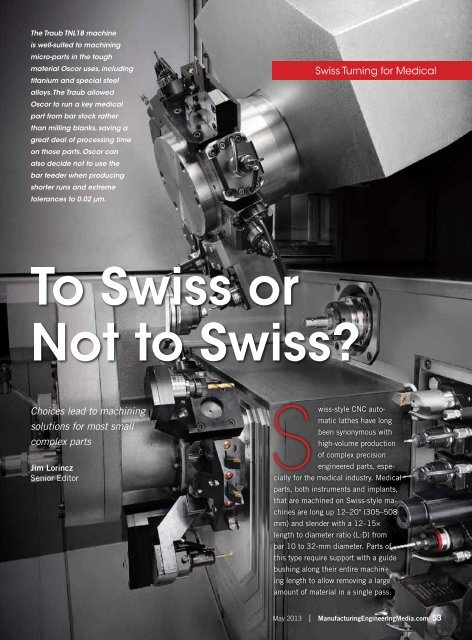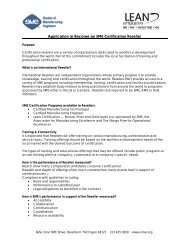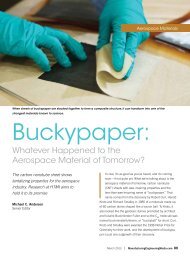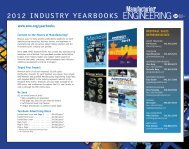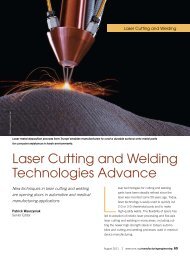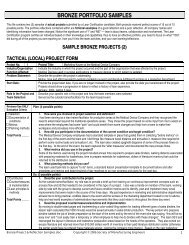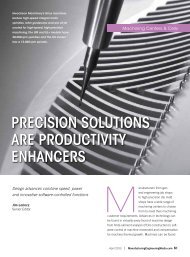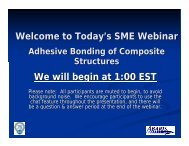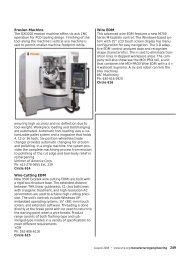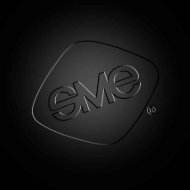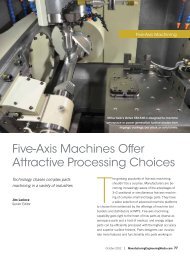Click here for PDF - Society of Manufacturing Engineers
Click here for PDF - Society of Manufacturing Engineers
Click here for PDF - Society of Manufacturing Engineers
You also want an ePaper? Increase the reach of your titles
YUMPU automatically turns print PDFs into web optimized ePapers that Google loves.
Swiss Turning <strong>for</strong> MedicalLong slender parts typical <strong>of</strong> those <strong>for</strong> medical and evenautomotive applications account, however, <strong>for</strong> only aboutone-third <strong>of</strong> all the small complex parts that are available tobe machined on CNC automatic lathes. The balance <strong>of</strong> theseparts are short and can be machined closer to the headstockwithout either a guide bushing <strong>for</strong> support or ground orprecision-drawn barstock needed with a guide bushing <strong>for</strong>consistent machining results. Most important, these smallprecision parts fit into the work envelope <strong>of</strong> CNC automaticlathes and benefit from the speedy cycle times, quality surfacefinishes and quick changeovers that are characteristic<strong>of</strong> Swiss machining technology.Sizing Up Swiss Machine AdvantagesJob shops are increasingly becoming aware <strong>of</strong> the opportunitiesthat CNC automatic lathe machining <strong>of</strong>fers. Keyconsiderations in making a machine selection include thecomplexity <strong>of</strong> parts, tolerances expected, and productionvolume required. Swiss-style machine trends include beingable to put multiple tools in the cut simultaneously usingquick-change gang-tooling slides or multiple turrets. In eithercase, using turret or gang-style tooling, Swiss machines canbe tooled up with enough tools <strong>for</strong> untended machining <strong>of</strong> themost complex parts and the toughest materials.“The distinguishing characteristic<strong>of</strong> a Swiss-style turning machine isthe sliding headstock that feeds barstock through a guide bushing.”Programming and setup, once thought to be barriers toadopting Swiss-style machining, have all but been eliminatedby advances in s<strong>of</strong>tware and machine design. Whatbuilder CNC controls and s<strong>of</strong>tware can’t supply is <strong>of</strong>ten, like3D modeling and simulation, providedby third-party s<strong>of</strong>tware. Machines canbe equipped with readily availabletools supplying a variety <strong>of</strong> machiningcapabilities including angular drilling(B-axis), deep-hole drilling, milling,tapping, thread whirling, and hobbing,high-pressure coolant systems, mist collectors,and other important productivityenhancing devices.CNC automatic lathes with powerfulmain and subspindles and a mix <strong>of</strong> liveand fixed front and back-working toolsprovide fast cycle times, dropping parts<strong>of</strong>f complete. Standard tooling is readilyavailable from suppliers today, makingsetup and changeover quick and easycompared with cam-driven screw machines.No grinding <strong>for</strong>m tools are needed<strong>for</strong> these machines. With the variety<strong>of</strong> precision-engineered parts available<strong>for</strong> machining on Swiss-style machines,it’s understandable why so many <strong>of</strong> themajor machine builders <strong>of</strong>fer variations<strong>of</strong> the technology with or without guidebushings and sliding headstock. Anothergroup <strong>of</strong> machine builders have devel-54 <strong>Manufacturing</strong>EngineeringMedia.com | May 2013
Swiss Turning <strong>for</strong> Medicaleter ratio. T<strong>here</strong> were no small non-Swiss machines available.With the Traub TNL series machines, the operator can changeover from Swiss to non-Swiss in 15 minutes and use the guidebush only when necessary <strong>for</strong> medical and automotive orother long parts,” said Koschig.“It takes just a few steps to convert the Traub TNL serieslathes from sliding-headstock to fixed-headstock turning modeand vice versa. The extremely long Z travel distance <strong>of</strong> theheadstock ensures proper positioning <strong>of</strong> the main spindle.The powerful main spindle is equipped with a C axis asstandard which delivers high torque to achieve large cuttingvolumes,” said Koschig.Complex Parts Machined Complete is the Standard“The B0326 32-mm Swiss-type machine can be quicklyand easily converted from direct-drive guide bushing bar-fedoperation to nonguide operation when fitted with the chuckerkit option, making it well-suited <strong>for</strong> short or prismatic partmachining,” said Ron Gainer, Tsugami/REM Sales. Thechucker option is increasingly popular <strong>for</strong> relatively shortparts like hardware, fasteners, electrical connectors, andeven medical parts like spinal hooks and short instrumentproducts. The B0326 is equipped with modular live tooling<strong>for</strong> quick changeovers and a large, easily accessible toolzone. A dual path Fanuc 32i-B CNC reduces cycle time furtherby permitting true simultaneous operation <strong>of</strong> the mainand subspindle.“Complex parts machined complete in the Swiss world isnothing new,” said Gainer. “S<strong>of</strong>tware functions have made themachines easier to use, making much more complex partseasier and eliminating secondary operations. A lot has to dowith advances in the machine plat<strong>for</strong>m, making them moremodular, more capabilities that you can pick <strong>of</strong>f the shelf andplug into the machine. Programming with Tsugami s<strong>of</strong>twareand third-party s<strong>of</strong>tware that <strong>of</strong>fers solid modeling w<strong>here</strong>required is easier and quicker,” said Gainer.58 <strong>Manufacturing</strong>EngineeringMedia.com | May 2013
“Once you get a customer in front <strong>of</strong> the Swiss machineand remove the guide bushing they can see that you’re processingthe part just like a lathe. In a gang-style machine, thetool is moved into position rather than a turret indexing. A toolindexes into position and you still go around with the sameaxes as a lathe with a Y axis. Tooling is arranged according tostandards. Turning tools have a standard projection length,but they can be set with a small set gage, or t<strong>here</strong> are featureson the machine that allow you to set them right <strong>of</strong>f the barstock diameter. Everything is on a standard tool-point plane sothat if all the tools are set the same, they have a zero <strong>of</strong>fset,enabling the tools to be set very quickly,” said Gainer.More Small Parts than Meet the Bushing“Traditional Swiss is only one part <strong>of</strong> small-parts machining,”said Willie Eichele <strong>of</strong> the Ganesh Technical Center(Cuyahoga Falls, OH), which will provide complex turnkey andautomation systems <strong>for</strong> Ganesh CNC automatic lathes. “Whenyou say Swiss machining everybody wants to assume theutilization <strong>of</strong> guide bushings, but on the Ganesh Cyclone CS32machine we’re sliding headstock we’re not Swiss. We don’tutilize a guide bushing. We typically feed the part out to lengthfrom the bar and then the headstock slides back and <strong>for</strong>thproviding the Z1 axis. With traditional Swiss machinining yourcollet or clamping device is located behind the bushing andyou’re basically pushing and pulling your barstock through thebushing so t<strong>here</strong>’s a difference,” said Eichele.For long slender parts traditional Swiss machining with aguide bushing is absolutely a must, because you are bringingyour cutting tool right up to the bushing providing the addedsupport required <strong>for</strong> long slender parts. That said, Ganeshdoesn’t build a bushing-style Swiss machine If you go back 10years or so, people started buying Swiss machines, becausethey have small work envelopes and gang tooling makingthem very fast acting. Twin-spindle machines that can dropparts <strong>of</strong>f complete very quickly, the Swiss with the bushingwas the only thing out t<strong>here</strong> that could give them a fast cycletime. Today, most <strong>of</strong> the parts out t<strong>here</strong> in screw machineshops don't have the length versus diameter ratios thatrequire the bushing approach. They’re parts that can supportthemselves and can be machined complete without a guidebushing,” said Eichele.“So then everybody backed up and said let’s take the Swissdesignedmachine with that small compact work envelope, usegang tools, get everything really tight in t<strong>here</strong> so we can makeMay 2013 | <strong>Manufacturing</strong>EngineeringMedia.com 59
Swiss Turning <strong>for</strong> Medicalparts fast, get rid <strong>of</strong> the bushing, and that’s basically w<strong>here</strong>Ganesh started, making parts 1 3/8" [37.5 mm] and smallerwithout a guide bushing t<strong>here</strong><strong>for</strong>e not requiring ground barstockor long wasted bar remnants," said Eichele.Medical Parts Get Precision MachiningHardinge Inc. (Elmira, NY) is well-known <strong>for</strong> its Swiss turningcomponents including Swiss-type headstock collets, pick<strong>of</strong>fcollets, carbide guide bushings, bar loader collets and custommanufactured solutions <strong>for</strong> Swiss turning.The Quest Super-Precision GT27gang-tool turning center is well-suited<strong>for</strong> machining medical components <strong>for</strong>neurological, orthopedic, spinal/bonefixation, dental implants, drug infusion,catheter connectors, optical, maxill<strong>of</strong>acial,micro/minimally invasive, surgicalinstrument applications.The GT27 is designed <strong>for</strong> machiningsmall diameters, complex andtight-tolerance parts, and other challengingrequirements, <strong>of</strong>fering continuousmachining accuracy <strong>of</strong> 0.0002"(0.005 mm) on diameter, part roundnessvariation <strong>of</strong> 0.000015" (0.00038mm) and part surface finish <strong>of</strong> 8 µin.Bar work up to 1 1/16" (27 mm) andchucked parts up to 4" (102 mm) indiameter (using a step chuck) can bemachined on the GT27.The GT27 features Hardinge’s interchangeabletop plate and quick-changecollet-ready spindle. The top platesecures to the dovetailed cross slideand is interchangeable <strong>for</strong> quick andaccurate tooling changes that can beper<strong>for</strong>med in under a minute. Pre-tooledtop plates can be quickly interchangedwithin 0.0002" repeatability to producea new part or family <strong>of</strong> parts. Hardinge’spatented collet-ready spindle providesmaximum rigidity and gripping powerbecause the collet seats directly in thespindle with minimum overhang fromthe spindle bearings. In this design thespindle accuracy is transferred directlyto the workpiece.The SR-20RIV from Star CNC MachineTool Corp. (Roslyn Heights, NY)features additional tool positions and60 <strong>Manufacturing</strong>EngineeringMedia.com | May 2013
Swiss Turning <strong>for</strong> MedicalAs many as 41 tools can be accommodated on the27-position toolstation <strong>of</strong> the Star SR-20RIV, providing avariety <strong>of</strong> tools <strong>for</strong> any machining requirements such as:deep-hole drilling, full B-axis machining, with C axis onmain and subspindle.full B axis on cross working (three-spindle attachment) <strong>for</strong>machining <strong>of</strong> very complicated components in one operation.As many as 41 tools can be accommodated on its 27-positiontoolstation, providing a variety <strong>of</strong> tools <strong>for</strong> any machining requirementssuch as: deep-hole drilling, full B-axis machining,with C axis on main and subspindle. A specially designed toolpost<strong>for</strong> back-working and Y-axis control function with eighttool positions and main and subspindles using built-in motorand sensor <strong>for</strong> improved indexing accuracy are featured. T<strong>here</strong>sult is reduced machining time and improved capability inan accurate rigid machine.The new SW-20 Swiss-type automatic lathe from Star isequipped with s<strong>of</strong>tware that enables complex components tobe manufactured in the fastest possible times. This evolutionarynew model was built to trans<strong>for</strong>m the productivity incomplex machining, with mechanical and control systemsdesigned to minimize noncutting time to the utmost level.The end result is improved production output, as well asgreater pr<strong>of</strong>itability. The SW-20 also <strong>of</strong>fers new functionssuch as manual handle retracing, program check, code andalarm help, among others, to assist the system operator. Bygiving the motor on the subspindle power equal to the mainspindle, the SW-20 also enhances the freedom to programefficiently. Features include eight-spindle toolpost with Y-axiscontrol function <strong>for</strong> back-end working and simultaneousmachining by opposing gang slides (two tool turning-two toolmilling/drilling). Electric drive eliminates hydraulic pressure,reducing idle time, and collets can be opened/closed evenduring high-speed operation. MEWant More In<strong>for</strong>mation?Ganesh Machinery Inc.Ph: 888-542-6374Web site: www.ganeshmachinery.comGosiger Inc.Ph: 800-888-4188Web site: www.gosigerautomation.comHardinge Inc.Ph: 607-734-2281Web site: www.hardinge.comIndex Corp.Ph: 317-770-6300Web site: www.indextraub.comStar CNCPh: 516-484-0500Web site: www.starcnc.comTsugami/REM SalesPh: 860-687-3400Web site: www.remsales.com62 <strong>Manufacturing</strong>EngineeringMedia.com | May 2013


